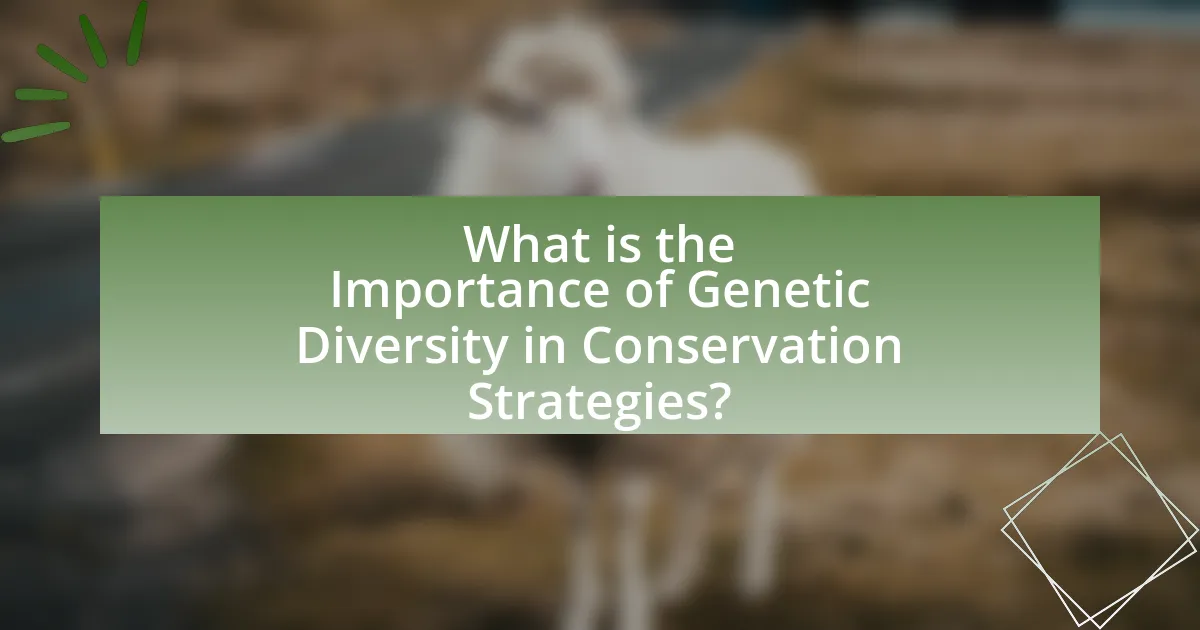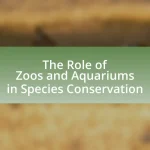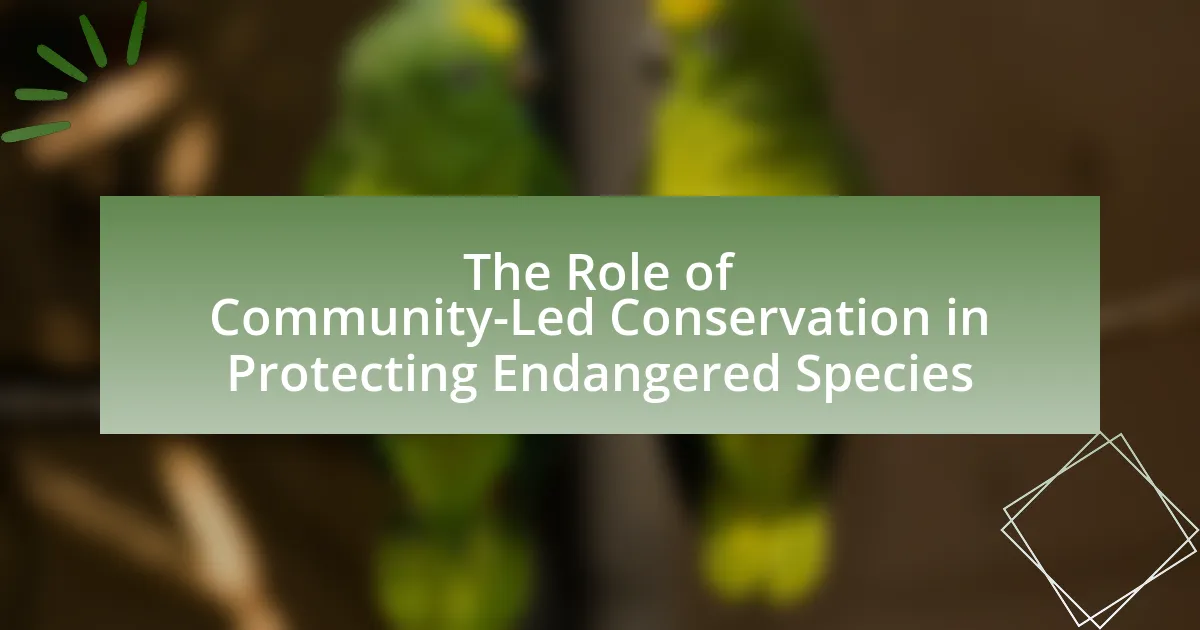Genetic diversity is a critical component of conservation strategies, enhancing species resilience to environmental changes and diseases. This article examines the significance of genetic diversity for species survival, its role in ecosystem stability, and the threats posed by habitat loss, climate change, and human activities. It also discusses strategies to enhance genetic diversity, including habitat restoration and breeding programs, and highlights the importance of genetic assessments in informing conservation efforts. By understanding and promoting genetic diversity, conservation initiatives can better support the adaptability and long-term viability of species in their natural habitats.

What is the Importance of Genetic Diversity in Conservation Strategies?
Genetic diversity is crucial in conservation strategies as it enhances the resilience of species to environmental changes and diseases. High genetic variability within populations allows for better adaptation to shifting habitats, climate change, and emerging pathogens. For instance, studies have shown that populations with greater genetic diversity are more likely to survive and thrive in changing environments, as evidenced by the recovery of the Florida panther, which benefited from genetic restoration efforts that increased its genetic diversity. This increased genetic variation leads to improved reproductive success and survival rates, ultimately supporting ecosystem stability and biodiversity conservation.
Why is genetic diversity crucial for species survival?
Genetic diversity is crucial for species survival because it enhances a population’s ability to adapt to changing environments and resist diseases. A genetically diverse population is more likely to possess individuals with traits that can withstand environmental stressors, such as climate change or habitat destruction. For instance, studies have shown that species with higher genetic variation, like the redwood tree, are more resilient to pests and diseases, which can lead to population stability and longevity. This adaptability is vital for maintaining ecosystem balance and ensuring the survival of species in the face of environmental challenges.
How does genetic diversity enhance resilience to environmental changes?
Genetic diversity enhances resilience to environmental changes by providing a broader range of traits that can improve survival and adaptation. This diversity allows populations to better withstand stressors such as climate change, disease, and habitat loss. For instance, studies have shown that genetically diverse populations of plants and animals are more likely to survive environmental fluctuations because they possess varying traits that may confer advantages under different conditions. Research published in the journal “Nature” by Elsworth et al. (2020) indicates that species with higher genetic variation exhibit greater adaptability, leading to increased survival rates in changing environments. Thus, genetic diversity is crucial for maintaining ecosystem stability and promoting long-term resilience against environmental challenges.
What role does genetic diversity play in disease resistance?
Genetic diversity enhances disease resistance by providing a broader range of genetic variations that can improve the ability of populations to adapt to pathogens. This variation allows for the presence of individuals with traits that may confer resistance to specific diseases, thereby increasing the overall survival and reproductive success of the population. For instance, studies have shown that populations with higher genetic diversity exhibit greater resilience to diseases such as chytridiomycosis in amphibians, where genetically diverse populations were less affected than those with low diversity. This evidence underscores the critical role of genetic diversity in maintaining healthy populations capable of withstanding disease outbreaks.
How does genetic diversity contribute to ecosystem stability?
Genetic diversity contributes to ecosystem stability by enhancing resilience to environmental changes and disturbances. This diversity allows populations to adapt to varying conditions, such as climate fluctuations, disease outbreaks, and habitat alterations. For instance, a study published in the journal “Nature” by Elmqvist et al. (2003) demonstrated that ecosystems with higher genetic variation among species exhibited greater stability and productivity. This is because diverse genetic traits enable species to exploit different resources and niches, reducing competition and promoting coexistence. Thus, genetic diversity is crucial for maintaining the balance and functionality of ecosystems.
What are the implications of reduced genetic diversity on ecosystem functions?
Reduced genetic diversity negatively impacts ecosystem functions by diminishing resilience, productivity, and stability. Ecosystems with low genetic diversity are less able to adapt to environmental changes, leading to increased vulnerability to diseases and climate fluctuations. For instance, a study published in the journal “Nature” found that plant populations with higher genetic diversity exhibited greater resistance to pests and diseases, thereby maintaining ecosystem productivity. Additionally, reduced genetic diversity can disrupt trophic interactions, as species that rely on one another may decline, leading to cascading effects throughout the ecosystem. This evidence underscores the critical role of genetic diversity in sustaining healthy and functional ecosystems.
How does genetic diversity affect interspecies interactions?
Genetic diversity significantly influences interspecies interactions by enhancing ecosystem resilience and stability. Higher genetic variation within species leads to a greater range of traits, which can improve adaptability to environmental changes and pressures, thereby facilitating more robust interactions among different species. For instance, diverse plant populations can provide varied resources for herbivores, which in turn supports a wider array of predators. Research indicates that ecosystems with high genetic diversity are better equipped to withstand disturbances, such as disease outbreaks or climate fluctuations, which can disrupt interspecies relationships. A study published in “Nature” by Elmqvist et al. (2003) demonstrated that genetic diversity within plant species positively correlates with the diversity of associated animal species, highlighting the critical role of genetic variation in maintaining healthy interspecies dynamics.

What are the main threats to genetic diversity in conservation?
The main threats to genetic diversity in conservation include habitat loss, climate change, overexploitation, pollution, and invasive species. Habitat loss, driven by urbanization and agriculture, reduces the available space for species to thrive, leading to population declines and genetic bottlenecks. Climate change alters ecosystems and species distributions, further threatening genetic diversity by isolating populations. Overexploitation, such as overfishing and hunting, depletes species and reduces their genetic variability. Pollution introduces harmful substances that can affect reproductive success and survival rates, while invasive species can outcompete native species, disrupting local genetic pools. These factors collectively undermine the resilience of ecosystems and the ability of species to adapt to changing environments.
How do habitat loss and fragmentation impact genetic diversity?
Habitat loss and fragmentation significantly reduce genetic diversity within populations. When habitats are destroyed or divided, the remaining populations become isolated, leading to inbreeding and a decrease in genetic variation. For instance, a study published in the journal “Conservation Biology” found that fragmented populations of the Florida panther exhibited reduced genetic diversity, which resulted in health issues and lower reproductive success. This loss of genetic diversity compromises the ability of species to adapt to environmental changes, making them more vulnerable to extinction.
What are the consequences of isolated populations on genetic variation?
Isolated populations lead to reduced genetic variation due to limited gene flow between groups. This isolation can result in inbreeding, which increases the likelihood of genetic disorders and decreases adaptability to environmental changes. For example, studies have shown that the Florida panther population, which became isolated, experienced a significant decline in genetic diversity, leading to health issues and reduced survival rates. Additionally, isolated populations may become more susceptible to extinction as they lack the genetic diversity necessary to adapt to new challenges, such as disease outbreaks or climate change.
How does climate change threaten genetic diversity?
Climate change threatens genetic diversity by altering habitats and ecosystems, which can lead to population declines and increased extinction rates. As temperatures rise and precipitation patterns shift, many species struggle to adapt to these rapid changes, resulting in reduced genetic variation within populations. For instance, a study published in the journal “Nature” found that climate change has already caused shifts in species distributions, leading to isolated populations that experience inbreeding and loss of genetic diversity. This loss of genetic diversity diminishes a species’ ability to adapt to environmental changes, ultimately jeopardizing their survival and the overall health of ecosystems.
What human activities contribute to the decline of genetic diversity?
Human activities that contribute to the decline of genetic diversity include habitat destruction, overexploitation of species, pollution, and climate change. Habitat destruction, such as deforestation and urbanization, reduces the available space for species to thrive, leading to population declines and loss of genetic variation. Overexploitation, through practices like overfishing and hunting, can drastically reduce population sizes, further diminishing genetic diversity. Pollution introduces harmful substances into ecosystems, affecting the health and reproductive success of various species, which can also lead to reduced genetic variation. Climate change alters habitats and species distributions, creating challenges for survival and reproduction, ultimately impacting genetic diversity. These activities have been documented in studies, such as the 2019 report by the Intergovernmental Science-Policy Platform on Biodiversity and Ecosystem Services, which highlights the significant threats to biodiversity and genetic diversity due to human actions.
How does pollution affect genetic health in populations?
Pollution negatively impacts genetic health in populations by introducing harmful substances that can cause mutations and reduce genetic diversity. For instance, exposure to heavy metals and persistent organic pollutants has been linked to increased mutation rates in various species, leading to a decline in population fitness and adaptability. Research conducted by the University of California, Davis, found that populations exposed to high levels of pollutants exhibited reduced genetic variation, which is critical for resilience against environmental changes. This reduction in genetic diversity can ultimately threaten the survival of species, as it limits their ability to adapt to new challenges, such as climate change and disease outbreaks.
What is the impact of overexploitation on genetic diversity?
Overexploitation significantly reduces genetic diversity within populations. This reduction occurs because the removal of individuals, often through activities like overfishing or hunting, leads to a smaller gene pool, which diminishes the ability of species to adapt to environmental changes. For example, studies have shown that overfishing in certain fish populations has led to a decrease in genetic variability, making these populations more susceptible to diseases and less resilient to changes in their habitats. The loss of genetic diversity can ultimately threaten the survival of species, as evidenced by the decline of various marine and terrestrial species due to unsustainable harvesting practices.

What strategies can enhance genetic diversity in conservation efforts?
Strategies that can enhance genetic diversity in conservation efforts include habitat restoration, translocation of individuals, and the establishment of wildlife corridors. Habitat restoration increases the availability of diverse environments, allowing for the support of various genetic lineages. Translocation involves moving individuals from one population to another to introduce new genetic material, which can reduce inbreeding and increase resilience. Wildlife corridors facilitate gene flow between isolated populations, promoting genetic exchange and diversity. Research has shown that these strategies can significantly improve the genetic health of endangered species, as evidenced by the successful recovery of the Florida panther through genetic management practices.
How can conservation programs incorporate genetic diversity?
Conservation programs can incorporate genetic diversity by implementing strategies such as habitat protection, breeding programs, and genetic monitoring. Habitat protection ensures that ecosystems maintain a variety of species, which supports genetic variation. Breeding programs can introduce individuals from different populations to enhance genetic diversity, as seen in the recovery efforts for the Florida panther, where genetic mixing improved population health. Genetic monitoring involves assessing the genetic variation within populations to inform management decisions, ensuring that conservation efforts prioritize maintaining or increasing genetic diversity. These approaches are supported by research indicating that higher genetic diversity enhances resilience to environmental changes and disease, ultimately contributing to the long-term survival of species.
What role do breeding programs play in maintaining genetic diversity?
Breeding programs play a crucial role in maintaining genetic diversity by systematically managing the reproduction of species to enhance genetic variation. These programs aim to prevent inbreeding depression and loss of genetic variability, which can occur in small or isolated populations. For instance, the Florida panther breeding program successfully introduced individuals from Texas to increase genetic diversity, resulting in improved health and reproductive success among the panther population. Such initiatives demonstrate that targeted breeding strategies can effectively bolster genetic diversity, which is essential for the resilience and adaptability of species in changing environments.
How can habitat restoration support genetic diversity?
Habitat restoration can support genetic diversity by creating environments that allow for the re-establishment of native species and their populations. When habitats are restored, they provide the necessary conditions for various species to thrive, which in turn facilitates gene flow among populations. For instance, a study published in the journal “Ecological Applications” by Hobbs and Harris (2001) demonstrated that restored habitats can enhance the genetic diversity of plant species by increasing the availability of resources and suitable conditions for reproduction. This genetic diversity is crucial for species’ adaptability to changing environments and resilience against diseases, ultimately contributing to ecosystem stability.
What are the best practices for monitoring genetic diversity?
The best practices for monitoring genetic diversity include utilizing molecular techniques, conducting regular population assessments, and implementing long-term monitoring programs. Molecular techniques, such as DNA sequencing and microsatellite analysis, provide precise measurements of genetic variation within and between populations. Regular population assessments, which involve estimating population sizes and structures, help identify changes in genetic diversity over time. Long-term monitoring programs ensure consistent data collection, allowing for the detection of trends and the effectiveness of conservation strategies. These practices are supported by studies indicating that effective monitoring can lead to better management decisions and improved conservation outcomes, as seen in the work of Frankham et al. (2010) in “Genetics and Conservation Biology.”
How can genetic assessments inform conservation strategies?
Genetic assessments can inform conservation strategies by identifying genetic diversity within populations, which is crucial for their long-term survival. These assessments reveal the genetic health of species, allowing conservationists to prioritize efforts for populations that are genetically impoverished or at risk of inbreeding. For instance, studies have shown that populations with higher genetic diversity are more resilient to environmental changes and diseases, as evidenced by the recovery of the Florida panther, which benefited from genetic restoration efforts that increased its genetic diversity. By utilizing genetic assessments, conservation strategies can be tailored to enhance genetic diversity, thereby improving the adaptability and viability of species in their natural habitats.
What technologies are available for studying genetic diversity?
Technologies available for studying genetic diversity include next-generation sequencing (NGS), microsatellite analysis, single nucleotide polymorphism (SNP) genotyping, and DNA barcoding. Next-generation sequencing allows for high-throughput analysis of genetic material, providing comprehensive data on genetic variation within populations. Microsatellite analysis focuses on specific regions of DNA that are highly variable, making it useful for assessing genetic diversity and population structure. Single nucleotide polymorphism genotyping identifies variations at single nucleotide positions, which can reveal subtle differences in genetic diversity. DNA barcoding utilizes a short genetic sequence from a standardized region of the genome to identify species and assess biodiversity. These technologies have been validated through numerous studies, demonstrating their effectiveness in understanding genetic diversity and informing conservation strategies.
What practical steps can individuals take to support genetic diversity in conservation?
Individuals can support genetic diversity in conservation by participating in local conservation programs and supporting biodiversity-friendly practices. Engaging in habitat restoration projects helps maintain and enhance ecosystems, which is crucial for preserving genetic diversity among species. Additionally, individuals can promote sustainable agriculture by choosing to buy organic and locally sourced products, which often support diverse crop varieties and reduce reliance on monocultures.
Supporting organizations that focus on wildlife conservation and genetic research also contributes to efforts aimed at maintaining genetic diversity. For example, initiatives like the Seed Savers Exchange work to preserve heirloom plant varieties, thereby supporting agricultural biodiversity. Furthermore, individuals can educate themselves and others about the importance of genetic diversity, fostering a community that values and actively participates in conservation efforts.




